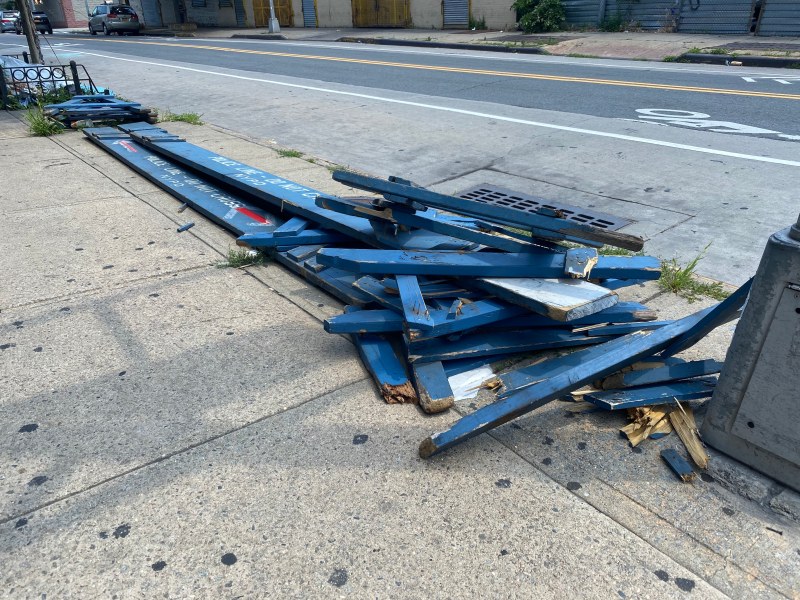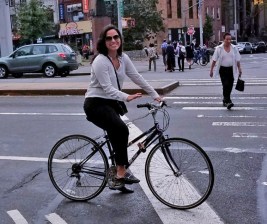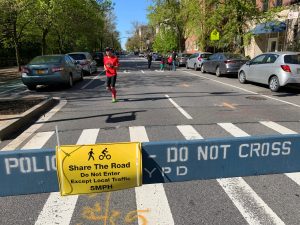Mayor de Blasio’s ‘Open Streets’ Implementation Falls Short: Report

Mayor de Blasio’s coronavirus-forced program to create car-free streets for people to recreate in a socially distanced manner is a failure that “lacks vision and ambition,” the city’s top street safety advocacy group said today.
The program to create 100 miles of temporary open space could have been “a serious tool to support our city’s recovery and transportation needs,” but instead it is a “disconnected network of public space islands with management challenges” that favors well-to-do areas, Transportation Alternatives said in a comprehensive review [PDF].
Today, we took a ride down Berry St & what we found was appalling! MOST of their #openstreets barriers were broken, missing legs, or non-existent. This is a one mile stretch that was home to many happy kids. @NYC_DOT how exactly do we get NYPD to redeploy barriers? pic.twitter.com/Sx2xMoGJjP
— North Brooklyn Open Streets (@nbkopenstreets) July 21, 2020
In its key findings, the group found:
- The average open streets is just 0.22 miles in length, and half are 0.16 miles or less in length.
- The NYPD manages 77 percent of open streets, and many outlets have found that the agency’s oversight is scattershot. The report follows up on prior reporting that six open streets have been reduced in length and 11, or 2.5 miles, were eliminated entirely without warning. “The majority of open streets that were shrunk or eliminated were under NYPD management,” the report said.
- Only 37 percent of New Yorkers live within walking distance of an open street.
- More than a quarter of open street mileage is located in or adjacent to parks, “where open space is least needed,” the group said.
- The distribution of open streets disenfranchises communities of color. According to TransAlt, only 20.5 percent of New Yorkers who live within walking distance of an open street are Black.
In addition, the plan includes pop-up bike lanes in a manner that is also flawed, the group said:
- Manhattan will end up with 54 percent of temporary protected bike lane miles, despite already being the borough with the most bike lanes,” the group said.
- The Bronx will get none — despite being the borough where cycling injuries are soaring, as Streetsblog reported.
- Only 7.88 miles, or 44 percent, of the proposed 18.07 miles of “pop-up” bike lanes have been implemented.
“Open Streets have the potential to support New York City’s recovery and create a more equitable city,” said Danny Harris, the group’s executive director. “The Department of Transportation deserves credit for what it has achieved so far — reclaiming space from cars is never easy in this city. We look forward to continuing to work together on a more ambitious program that can fully embrace the endless possibilities of open streets.”
As such, the group offered recommendations for making open streets better:
- The open street segments should be longer and connected.
- They should be reconfigured as “transportation corridors by converting arterials which parallel subway lines into open streets.”
- The most successful open streets — such as 34th Avenue in Jackson Heights — should be permanently car-free (as Streetsblog reported). Such a move would “help not only with the stated goals of open streets, but also reduce crashes, address equity issues related to public space, and help meet climate goals,” the group said.
- Locate new Open Streets in locations where there is the least open space and the fewest transportation choices.
- Helping community groups adopt open streets so the police would no longer need to manage the space.
After initial publication of this story, City Hall spokesman Mitch Schwartz sent over a statement:
“We’re grateful for the feedback and creative thinking. We’re proud of our unprecedented and nation-leading Open Streets program, which New Yorkers across the city have used to enjoy the outdoors while staying safe from COVID-19. We’re looking forward to expanding the program and finding more ways than ever to use our urban landscape to emerge from this crisis a fairer, better city.”




